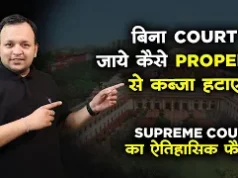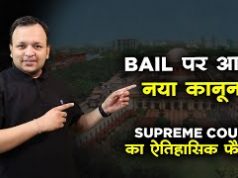Aapka Consultant Judgment Series- In this series, we are providing case analysis of Landmark Judgments of Hon’ble Supreme Court of India.
Associated Hotels of India Ltd. vs. R.N. Kapoor
AIR1959SC1262, [1960]1SCR368
Hon’ble Judges/Coram: A.K. Sarkar, K. Subba Rao and S.K. Das, JJ.
Date of Decision: 19.05.1959
FACTS:-
The respondent occupied two rooms in the appellant’s hotel, described as the Ladies’ and Gents’ Cloak Rooms, where he used to carry on his business as a hair-dresser. The document executed by the parties purported to be one as between a licenser and licensee and provided, inter alia, that the respondent was to pay a monthly rent of Rs. 800, which was later reduced to Rs. 700/month by mutual agreement. The respondent made an application for standardisation of rent under s. 7(1) of the Delhi and Ajmer-Merwara Rent Control Act, 1947 (hereinafter called ‘the Act’), and the Rent Controller of Delhi fixed the rent at Rs. 94 per month. On appeal by the appellant, the District judge reversed the order of the Rent Controller and dismissed the application holding that the Act did not apply. The High Court in revision set aside the order of the District judge and restored that of the Rent Controller, holding that the agreement created a lease and not a license and that S. 2 of the Act did not exempt the two rooms from the operation of the Act. Hence this appeal.
ISSUE:-
The two questions for determination in this appeal were:
- Whether the agreement created a lease or a license? And,
- Whether the said rooms were rooms in a hotel within the meaning of s. 2(b) of the Act?
JUDGMENT:-
With regards to the first issue, Court observes that the document no doubt uses phraseology appropriate to a licence, but it is the substance of the agreement that matters and not the form, for otherwise clever drafting can camouflage the real intention of the parties. According to Court there is a marked distinction between a lease and a licence. Section 105 of the Transfer of Property Act defines a lease of immovable property as a transfer of a right to enjoy such property made for a certain time in consideration for a price paid or promised. Under s. 108 of the said Act, the lessee is entitled to be put in possession of the property. A lease is therefore a transfer of an interest in land. The interest transferred is called the leasehold interest. The lessor parts with his right to enjoy the property during the term of the lease, and it follows from it that the lessee gets that right to the exclusion of the lessor. Whereas, under Section 52 of the Indian Easements Act which defines a licence, if a document gives only a right to use the property in a particular way or under certain terms while it remains in possession and control of the owner thereof, it will be a licence. The legal possession, therefore, continues to be with the owner of the property, but the licensee is permitted to make use of the premises for a particular purpose. But for the permission, his occupation would be unlawful. It does not create in his favour any estate or interest in the property. There is, therefore, clear distinction between the two concepts. The dividing line is clear though sometimes it becomes very thin or even blurred.
The following propositions may, therefore, be taken as well-established : (1) To ascertain whether a document creates a licence or lease, the substance of the document must be preferred to the form; (2) the real test is the intention of the parties – whether they intended to create a lease or a licence; (3) if the document creates an interest in the property, it is a lease; but, if it only permits another to make use of the property, of which the legal possession continues with the owner, it is a licence; and (4) if under the document a party gets exclusive possession of the property, prima facie, he is considered to be a tenant; but circumstances may be established which negative the intention to create a lease.
Judged by the said tests, Court held that that the document is one of licence. Certainly it does not confer only a bare personal privilege on the respondent to make use of the rooms. It puts him in exclusive possession of them, untrammelled by the control and free from the directions of the appellants. The covenants are those that are usually found or expected to be included in a lease deed. The right of the respondent to transfer his interest under the document, although with the consent of the appellants, is destructive of any theory of licence. The solitary circumstance that the rooms let out in the present case are situated in a building wherein a hotel is run cannot make any difference in the character of the holding. The intention of the parties is clearly manifest, and the clever phraseology used or the ingenuity of the document-writer hardly conceals the real intent. Therefore, it was held that under the document there was transfer of a right to enjoy the two rooms, and, hence, it created a tenancy in favour of the respondent.
Now, for the purpose of second issue, Court refers to the Section 2(b) of the Delhi and Ajmer-Merwara Rent Control Act 1947, which is provided as follows:-
“Section 2: In this Act, unless there is anything repugnant in the subject or context-
Premises’ means any building or part of a building which is, or is intended to be, let separately for use as a residence or for commercial use or for any other purpose…… but does not include a room in a dharamshala, hotel or lodging house.”
Court observes that for the purpose of the present case it may be stated that the object of the Act is to control rents and evictions. Section 3 says that no tenant shall be liable to pay for occupation of any premises any sum in excess of the standard rent of these premises. Section 2(d) defines a tenant as a person who takes on rent any premises. Section 2(b) defines what is a premises within the meaning of the Act. Section 2(c) provides how standard rent in relation to any premises is to be determined. It is clear from these provisions of the Act that standard rent can be fixed only in relation to premises as defined in the Act and only a tenant, that is, the person to whom the premises have been let out, can ask for the fixing of the standard rent. Moreover, it is clear from definition of the term ‘premises’ that the Act did not intend to control the rents payable by and evictions of, persons who take on rent rooms in a dharamshala, hotel or lodging house.
The language used in the Act is “room in a………..hotel”. The word “hotel” here must refer to a building for a room in a hotel must be a room in a building. That building no doubt must be a hotel, that is to say, a building in which the business of a hotel is carried on. The language used in the Act would include any room in the hotel building. That is its plain meaning. Unless there is good reason to do otherwise, that meaning cannot be departed from.
In a physical sense the rooms in question were undoubtedly rooms in that hotel. A strictly literal construction may not be justified and the word ‘room’ in the composite expression ‘room in a hotel’ must take colour from the context or the collocation of words in which it has been used; in other words, its meaning should be determined noscitur a sociis. On this view, a room in a hotel must fulfil two conditions: (1) it must be part of a hotel in the physical sense and (2) its user must be connected with the general purpose of the hotel of which it is a part. In the present case under consideration, the spaces were let out for carrying on the business of a hair dresser. Such a business is one of the amenities which a modern hotel provides. The circumstance that people not resident in the hotel might also be served by the hair dresser does not alter the position; it is still an amenity for the residents in the hotel to have a hair dressing saloon within the hotel itself. A modern hotel provides many facilities to its residents; some hotels have billiard rooms let out to a private person where residents of the hotel as also non-residents can play billiards on payment of a small fee; other hotels provide post-office and banking facilities by letting out rooms in the hotel for that purpose. All these amenities are connected with the hotel business and a barber’s shop within the hotel premises is no exception.
HELD:-
In the aforesaid paragraphs, test is laid down to ascertain the nature of document whether it is lease or license. Apart from that, it is also held that a room in a hotel within the definition is any room in a building in the whole of which the business of a hotel is run. So understood, the definition would include the spaces in the cloak rooms of the Imperial Hotel in the present case. These spaces are, in majority view, rooms in a hotel and excluded from the operation of the Act.
To Get Legal Opinion from Advocates/ Legal Experts, Please click here
To Get Legal Opinion from Retired Hon’ble Judges, Please click here












